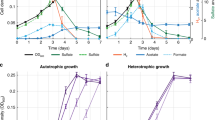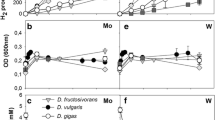Abstract
Desulfovibrio baarsii is a sulfate reducing bacterium, which can grown on formate plus sulfate as sole energy source and formate and CO2 as sole carbon sources. It is shown by 14C labelling studies that more than 60% of the cell carbon is derived from CO2 and the rest from formate. The cells thus grow autotrophically. Labelling studies with [14C]acetate, 14CO and [14C]formate indicate that CO2 fixation does not proceed via the Calvin cycle. The labelling patterns of alanine, aspartate, glutamate, and glucosamine indicate that acetate (or activated acetic acid) is an early intermediate in formate and CO2 assimilation; the methyl group of acetate is derived from formate, and the carboxyl group from CO2 via CO; pyruvate is formed from acetyl-CoA by reductive carboxylation. The capacity to synthesize an acetate unit from two C1-compounds obviously distinguishes D. baarsii from those Desulfovibrio species, which require acetate as a carbon source in addition to CO2.
Similar content being viewed by others
References
Alvarez M, Barton LL (1977) Evidence for the presence of phosphoriboisomerase and ribulose-1,5-diphosphate carboxylase in extracts of Desulfovibrio vulgaris. J Bact 131:133–135
Bache R, Pfennig N (1981) Selective isolation of Acetobacterium woodii on methoxylated aromatic acids and determination of growth yields. Arch Microbiol 130:255–261
Badziong W, Thauer RK, Zeikus JG (1978) Isolation and characterization of Desulfovibrio growing on hydrogen plus sulfate as the sole energy source. Arch Microbiol 116:41–49
Badziong W, Ditter B, Thauer RK (1979) Acetate and carbon dioxide assimilation by Desulfovibrio vulgaris (Marburg), growing on hydrogen and sulfate as sole energy source. Arch Microbiol 123:301–305
Barton LL (1981) Significance of chemolithotrophy and carbon dioxide fixation in the sulphate-reducing bacteria. In: Dalton H (ed) Microbial growth on C1 compounds. Heyden, London Philadelphia Rheine, pp 83–91
Brandis A, Thauer RK (1981) Growth of Desulfovibrio species on hydrogen and sulphate as sole energy source. J Gen Microbiol 126:249–252
Brandis-Heep A, Gebhardt NA, Thauer RK, Widdel F, Pfennig N (1983) Anaerobic acetate oxidation to CO2 by Desulfobacter postgatei. 1. Demonstration of all enzymes required for the operation of the citric acid cycle. Arch Microbiol 136:222–229
Butlin KR, Adams ME (1947) Autotrophic growth of sulphate-reducing bacteria. Nature (London) 160:154–155
Daniels L, Fuchs G, Thauer RK, Zeikus JG (1977) Carbon monoxide oxidation by methanogenic bacteria. J Bacteriol 132:118–126
Dickert G, Thauer RK (1978) Carbon monoxide oxidation by Clostridium thermoaceticum and Clostridium formicoaceticum. J Bact 136:597–606
Diekert G, Ritter M (1983) Carbon monoxide fixation into the carboxyl group of acetate during growth of Acetobacterium woodii on H2 and CO2. FEMS Microbiol Lett 17:299–302
Eden G, Fuchs G (1982) Total synthesis of acetyl CoA involved in autotrophic CO2 fixation in Acetobacterium woodii. Arch Microbiol 133:66–74
Fuchs G, Stupperich E, Thauer RK (1978) Acetate assimilation and the synthesis of alanine, aspartate and glutamate in Methanobacterium thermoautotrophicum. Arch Microbiol 117:61–66
Fuchs G, Stupperich E (1980) Acetyl CoA, a central intermediate of autotrophic CO2 fixation in Methanobacterium thermoautotrophicum. Arch Microbiol 127:267–272
Fuchs G, Stupperich E (1983) CO2 fixation pathways in bacteria. Physiol Veg 21:845–854
Fuchs G, Stupperich E, Eden G (1980) Autorophic CO2 fixation in Chlorobium limicola. Evidence for the operation of a reductive tricarboxylic acid cycle in growing cells. Arch Microbiol 128: 64–71
Gebhardt NA, Linder D, Thauer RK (1983) Anaerobic acetate oxidation to CO2 by Desulfobacter postgatei. 2. Evidence from 14C-labelling studies for the operation of the citric acid cycle. Arch Microbiol 136:230–233
Gottschalk G (1968) The stereospecificity of the citrate synthase in sulfate-recuding and photosynthetic bacteria. Eur J Biochem 5:346–351
Gottschalk G, Barker HA (1967) Presence and stereospecificity of citrate synthase in anaerobic bacteria. Biochemistry 6:1027
Gutmann I, Wahlefeld W (1974) L-(+)-Lactat. Bestimmung mit Lactat-Dehydrogenase und NAD. In: Bergmeyer HU (ed) Methoden der enzymatischen Analyse, vol 2. Verlag Chemie, Weinheim, pp 1510–1514
Höpner T, Knappe J (1974) Bestimmung mit Formiat-Dehydrogenase. In: Bergmeyer HU (ed) Methoden der enzymatischen Analyse, vol 2. Verlag Chemie, Weinheim, pp 1596–1600
Hu SI, Drake HL, Wood HG (1982) Synthesis of acetyl Coenzyme A from carbon monoxide, methyltetrahydrofolate, and Coenzyme A by enzymes from Clostridium thermoaceticum. J Bacteriol 149:440–448
Jansen K, Stupperich E, Fuchs G (1982) Carbohydrate synthesis from acetyl CoA in the autotroph Methanobacterium thermoautotrophicum. Arch Microbiol 132:355–364
Kenealy WR, Zeikus JG (1982) One-carbon metabolism in methanogens: Evidence for synthesis of a two-carbon cellular intermediate and unification of catabolism and anabolism in Methanosarcina barkeri. J Bacteriol 151:932–941
Ljungdahl L, Wood HG (1982) Acetate synthesis. In: Dolphin D (ed) Vitamin B12. Academic Press, New York, pp 165–202
Pfennig N, Widdel F (1981) Ecology and physiology of some anaerobic bacteria from the microbial sulfur cycle. In: Bothe H, Trebst A (eds) Biology of inorganic nitrogen and sulfur. Springer, Berlin Heidelberg New York, pp 169–177
Pfennig N, Widdel F (1982) The bacteria of the sulphur cycle. Phil Trans R Soc Lond Ser B 298:433–441
Pfennig N, Widdel F, Trüper HG (1981) The dissimilatory sulfate-reducing bacteria. In: Starr MP, Stolp H, Trüper HG, Balows A, Schlegel HG (eds) The prokaryotes, vol I. Springer, Berlin Heidelberg New York, pp 926–940
Postgate J (1970) Carbon monoxide as a basis for primitive life on other planets: a comment. Nature (London) 226:978
Postgate JR (1979) The sulphate-reducing bacteria. Cambridge University Press, Cambridge London New York Melbourne
Rittenberg SC (1969) The roles of exogenous organic matter in the physiology of chemolithotrophic bacteria. Adv Microbiol Physiol 3:159–195
Simon H, Floss HG (1967) Bestimmung der Isotopenverteilung in markierten Verbindungen. Springer, Berlin Heidelberg New York
Sisler FD, Zobell CE (1950) Hydrogen-utilizing, sulfate-reducing bacteria in marine sediments. J Bacteriol 60:747–756
Sisler FD, Zobell CE (1951) Hydrogen utilization by some marine sulfate-reducing bacteria. J Bacteriol 62:117–127
Sorokin Y (1966a) Sources of energy and carbon for biosynthesis in sulfate-reducing bacteria. Microbiology USSR 35:643–647
Sorokin Y (1966b) Investigations of the structural metabolism of sulfate-reducing bacteria with 14C. Microbiology USSR 35:806–814
Sorokin Y (1966c) Role of carbon dioxide in the biosynthesis by sulphate reducing bacteria. Nature (London) 210:551–552
Stupperich E, Fuchs G (1984a) Autotrophic synthesis of activated acetic acid from two CO2 in Methanobacterium thermoautotrophicum I. Properties of in vitro system. Arch Microbiol (in press)
Stupperich E, Fuchs G (1984b) Autotrophic synthesis of activated acetic acid from two CO2 in Methanobacterium thermoautotrophicum. II. Evidence for different origins of acetate carbon atoms. Arch Microbiol (in press)
Stupperich E, Hammel KE, Fuchs G, Thauer RK (1983) Carbon monoxide fixation into the carboxyl group of acetyl Coenzyme A during autotrophic growth of Methanobacterium. FEBS Lett 152:21–23
Taylor GT, Kelly DP, Pirt SJ (1976) Intermediary metabolism in methanogenic bacteria (Methanobacterium). In: Schlegel HG, Gottschalk G, Pfennig N (eds) Proceedings of symposium on microbial production and utilization of gases (H2, CH4, CO), Akademie der Wissenschaften zu Göttingen. Goltze Göttingen, pp 173–180
Watson GR, Williams JP (1970) Rapid method for wet combustion and scintillation counting of 14C-labelled organic materials. Anal Biochem 33:356–365
Widdel F (1980) Anaerober Abbau von Fettsäuren und Benzoesäure durch neu isolierte Arten Sulfat-reduzierender Bakterien. Ph.D. thesis, University of Göttingen
Widdel F (1981) Validation of the publication of new names and new combinations previously effectively published outside the IJSB. Int J Syst Bacteriol 31:382–383
Widdel F, Kohring GW, Mayer F (1983) Studies on dissimilatory sulfate-reducing bacteria that decompose fatty acids. III. Characterization of the filamentous gliding Desulfonema limicola gen. nov. sp. nov., and Desulfonema magnum sp. nov. Arch Microbiol 134:286–294
Yagi T (1958) Enzymic oxidation of carbon monoxide. Biochim Biophys Acta 30:194–195
Yagi T (1959) Enzymic oxidation of carbon monoxide. J Biochem (Tokyo) 46:949–955
Author information
Authors and Affiliations
Rights and permissions
About this article
Cite this article
Jansen, K., Thauer, R.K., Widdel, F. et al. Carbon assimilation pathways in sulfate reducing bacteria. Formate, carbon dioxide, carbon monoxide, and acetate assimilation by Desulfovibrio baarsii . Arch. Microbiol. 138, 257–262 (1984). https://doi.org/10.1007/BF00402132
Received:
Accepted:
Issue Date:
DOI: https://doi.org/10.1007/BF00402132




